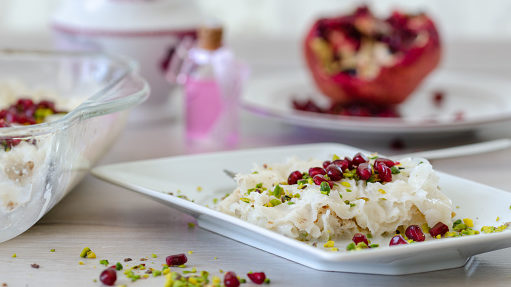The gullac is a delectable dessert that first came from Turkey and they are sold everywhere on the streets and in restaurants in the region. Compared to the baklava, the gullac is a healthier alternative as it is mainly composed of milk and fruits.
The name gullac stems from the combination of two Turkish words, Güllü and aş, which is then shortened to Güllaç to mean “rosy dish” or “food with roses”.The delectable dish was said to be made out of purely natural ingredients of mainly fruits and milk, with no additional additives that are generally found in manufactured foods.
The lightness of the dessert makes it perfect during the Ramadan month as it is easily digestible and gives enough energy after the long hours of fasting. More than 80% of the gullac was said to be consumed during Ramadan and it is prized food amongst the Turkish people.
What is Gullac?
The main ingredients of the gullac, include the sweetened milk, fresh pomegranate, wheat flour, rosewater, corn starch and walnuts. The sweet dessert has a fluffy white appearance that is made out of thin layers of corn starch, infused with rosewater milk and topped with walnuts and pomegranate, to create a visually-appealing dish.
To enhance the sweetness of the dessert rosewater will be doused all over the dish to give out a refreshing feeling when consumed, though it is optional to add it.Rosewater was an important ingredient during the Ottoman era, as it was said to be the fragrant and a food sweetener to the dish.
However, these days rose water is rarely ever used to make the gullac. When consumed, the gullac will melt in your mouth with the wonderful sweetness of the dessert that has a slight crunch to it.
History of Gullac
The origins of the gullac stretch all the way back to the 15th century in Turkey. Back then, the local people would make dough using corn starch, which was then dried under the sun during the hot summer days.
During the cold harsh winters, the dough will then be softened by immersing it in milk and sugar to be eaten. Back then, cornstarch was an important food, as it can be stored for the cold winters.The palace then caught wind of the dish in 1489 and adopted the food to create what we know today as the gullac.
The recipe of the gullac was further refined within the walls of the palace by the royal cooks and chefs, by using different flavourings. Ottoman women during that era were involved in making the gullac sheets by mixing cornstarch with plain water to soften and then left to dry in the open air outside under the summer weather.
The brittle-translucent cornstarch sheets are easy to store and they can last for up to months or even years. The dessert will then be prepared by immersing the cornstarch sheets with milk and sugar, doused with rose water on top to be eaten by the royal family and their guests, during important festivities.
The history of the gullac is similar to that of the history of baklava. During a banquet for the circumcision of the son of King Suleiman, gullac was presented to the royal family and their guests for the celebration.
Today, the gullac is used as a mark for the entire period of Ramadan in Turkey, where the Muslims will fast for the entire month, and it will be found everywhere along the streets in Turkey, ready to be consumed.
Need something sweet to satisfy your craving? Find more of European cuisine on foodpanda!
